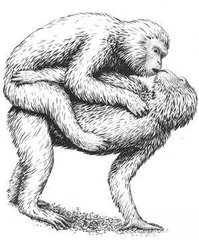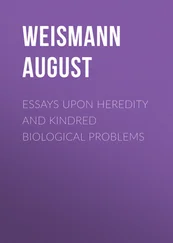Early descriptions of animal homosexuality often mistakenly called the animals “hermaphrodites,” since any “transgression” of gender categories (such as sexual behavior) was usually equated with physical gender-mixing. True hermaphroditism, however, involves animals that have both male and female reproductive organs at the same time. This phenomenon is found in many invertebrate organisms, such as slugs and worms, as well as in a number of fish species (for example, lantern fishes and some species of hamlets and deep-sea fishes). Some hermaphrodites can fertilize themselves, but mating in many hermaphroditic species involves two individuals having sex with each other in order to mutually exchange both eggs and sperm. 47Since both such individuals have identical biologies, i.e., are of the same (dual) sex, technically such behavior could be classified as homosexual. However, such activity differs from actual homosexuality because it occurs in a species that does not have two separate sexes, and because it typically does result in procreation. In species that do have two distinct sexes, there are other types of hermaphroditism or intersexuality, in which individuals combine various physical features of both sexes. These differ from species-wide, true hermaphroditism because such animals are not able to reproduce as both males and females simultaneously, and they usually comprise only a fraction of the otherwise nonhermaphroditic population. Further examples of this type of transgender will be discussed in chapter 6.
Virgin birth, or parthenogenesis, is not just the stuff of religions: it is actually found in over a thousand species worldwide and is a “natural” form of cloning. Each member of a parthenogenetic species is biologically female (that is, capable of producing eggs). Rather than requiring sperm to fertilize these eggs, however, she simply makes an exact copy of her own genetic code. Virgin birth is found in a number of fishes, lizards, insects, and other invertebrates. In most parthenogenetic species, individuals do not have sex with each other, but in some species, such as the Amazon Molly and Whiptail Lizards, females actually court and mate with one another, even though no eggs (or sperm) are exchanged in such encounters.
Whereas homosexuality and bisexuality involve activity within the same gender, hermaphroditism and parthenogenesis involve courtship and sexual behavior without genders (at least, without one class of individuals that are male and another class that are female). In contrast, transvestism and transsexuality are a kind of “crossing over” from one gender or sexual category to another, or the combining of elements from each category. In transvestism, individuals of one biological sex take on the characteristics of the other sex, either behaviorally or physically, without actually changing their own sex. In transsexuality, individuals actually become the opposite sex, so that a male turns into a female or vice versa (where male and female are used strictly in the reproductive sense to refer to animals that produce sperm or eggs, respectively).
Transvestism is widespread in the animal kingdom and takes a variety of forms. 48Both male-to-female and female-to-male transvestism occur: some female African swallowtail butterflies, for example, resemble males in their wing coloration and patterning, while in some species of squid, males imitate female arm postures during aggressive encounters. 49Physical transvestism can involve almost total physical resemblance between males and females, or mimicry of only certain primary or secondary sexual characteristics. For instance, in several species of North American perching birds, young males resemble adult females in their plumage—making them distinct from both adult males and juvenile females. In some birds, such as the painted bunting, the resemblance between adult females and juvenile males is nearly total, while in others, younger males are more intermediate between adult males and females in appearance. 50Several species of hoofed mammals show a different type of physical transvestism: female mimicry of the horns or tusks found in males. 51Female Chinese water deer, for example, grow special tufts of hairs on their jaws that resemble the tusks of the male, while female Musk-oxen have a patch of hair on their foreheads that mimics the males’ horn shield. Physical transvestism can also be chemical or scent-based: some male Common Garter Snakes, for example, produce a scent that resembles the female pheromone, causing males to mistake them for females and attempt to court and mate with them.
In behavioral transvestism, an animal of one sex acts in a way that is characteristic of members of the opposite sex of that species—often fooling other members of their own species. For example, males of several species of terns imitate female food-begging gestures to steal food from other males. Behavioral transvestism does not mean animals behaving in ways that are thought to be “typically” male or female in other species. In sea horses and pipefishes, for instance, the male bears and gives birth to the young. Even though these are activities usually thought to be “female,” this is not a genuine case of transvestism because it is part of the regular behavior patterns and biology of the species (i.e., it is true for all males and no females). Female sea horses never bear young, nor are they fooled into thinking that males aren’t male because they do bear young. The same goes for initiation of courtship: in some species the female is more aggressive in initiating courtship and copulation (e.g., in greater painted-snipes), yet this could only be considered “transvestism” with reference to other species in which females do not initiate such activity. 52
The question of transvestism is an important one for animal homosexuality because these two phenomena have often been confused. Many scientists have labeled all examples of animal homosexuality male or female “mimicry” since they consider any same-sex behavior to be nothing more than imitation of the opposite sex. True, many animals, when courting and mating homosexually, employ behavior patterns that the opposite sex also employs. In most cases, however, this simply involves making use of the available behavioral repertoire of the species rather than being an attempt to mimic the opposite sex. Moreover, the resemblance to “heterosexual” patterns is often partial at best, while in some species entirely distinct courtship and copulation patterns are used for homosexual activity. 53
A good example of the difference between behavioral transvestism and homosexuality is in the Bighorn Sheep. In this species, males and females lead almost entirely separate lives: they live in sex-segregated herds for most of the year and come together for only a few short months during the breeding season. Among males, homosexual mounting is common, while females do not generally permit themselves to be mounted by males except when they are in heat (estrus). A small percentage of males, however, are behavioral transvestites: they remain in the female herds year-round and also mimic female behavior patterns. Significantly, such males also generally refuse to allow other males to mount them, just the way females do. Thus, among Bighorn Sheep, being mounted by a male is a typically “masculine” activity, while refusal of such mounting is a typically “feminine” behavior. Males who mimic females specifically avoid homosexuality. This is the exact opposite of the stereotypical view of male homosexuality, which is often considered to be a case of males “imitating” females. It is also a striking reminder of how important it is not to be misled by our preconceptions about human homosexuality when looking at animals. 54
Transsexuality or sex change is a routine aspect of many animals’ lives, especially in invertebrates: shrimp, oysters, and sow bugs, for example, all undergo complete reversals of their sex at some stage in their lives. 55It is among coral-reef fish, however, that the most remarkable examples of transsexuality are found. More than 50 species of parrot fishes, wrasses, groupers, angelfishes, and other species are transsexual. In all such cases, the reproductive organs of the fish undergo a complete reversal. What were once fully functional ovaries, for example, become fully functional testes, and the formerly female fish is able to mate and reproduce as a male. 56
Читать дальше












